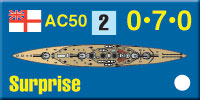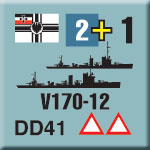Jutland 1919:
The Toys!
by Mike Bennighof, Ph.D.
March 2025
 Great War at Sea: Jutland 1919 is an expansion for our Jutland game, adding the giant battleships (plus some cruisers and destroyers) that never actually left the drawing boards. And you get 31 scenarios that let you play with the new ships. Great War at Sea: Jutland 1919 is an expansion for our Jutland game, adding the giant battleships (plus some cruisers and destroyers) that never actually left the drawing boards. And you get 31 scenarios that let you play with the new ships.
In further installments we’ll look at all of the new ships in some depth; let’s have a look at all of them. It’s a pretty impressive fleet.
Battleships
Jutland 1919 has a lot of battleships: a dozen German dreadnoughts, and eleven British. Each navy has three classes.
Britain leads off with the three units of the Revenge class cancelled at the outbreak of war. Legally speaking, their contracts were only “suspended” and two of those suspended contracts would be re-issued for new battle cruisers built under the same names and using some of the same 15-inch guns ordered for the battleships.
 
Next up is the battleship designed to follow the Queen Elizabeth class, to maximize firepower without increasing the ship’s length or draft (so that new docking facilities would not be needed). The Ocean class takes traditional names of British battleships; as this proposal was not formally adopted and no ships ordered, no names were assigned. It boosts firepower, from eight 15-inch guns to ten of them, by replacing two of the twin turrets of Queen Elizabeth with triple mounts. That extra weight reduced their speed to 22 knots.

The third class of battleship is another proposed design, derived from the battle cruiser Hood but carrying eight of the new 18-inch rifles rather than the standard 15-inch Mark I. The Nemesis class once again takes on traditional British battleship names, as it was never actually ordered. The huge main battery qualifies as “very large guns” under Great War at Sea’s rules, and so the primary gunnery factor is highlighted.
The three German battleship classes are all proposed designs that were never actually ordered. The Jasmund class takes the name of German or Prussian victories (or stalemates claimed as victories) and is the L1 design, the so-called “fast Baden.” The architects stretched the hull of the most recent battleship design, the Baden class, to add more boilers and increase the ship’s speed to 26 knots.
 
The L2 was a variant design, using the same hull but replacing some of the additional boilers with a fifth turret for a pair of 15-inch guns, atop a high, towering barbette so that it fired over both of the aft turrets. These are the Kaiser Friedrich III class, taking the names of an old, retired class of pre-dreadnought battleships.

After the Battle of Jutland, German ship designers were told to draft larger, faster ships with bigger guns. We have one of these designs, L20e, which the German Admiralty staff selected for construction in late 1917 even though she had no hope of actually being built amid the labor and material shortages. She’s a huge ship, with huge guns (16.5-inch, or 420mm), high speed and thick armor. Plus she qualifies for the Very Large Guns rule. The four ships carry traditional German battleship names; the German Navy did not formally assign names until a ship had been launched but Kaiser Wilhelm II had insisted that one of these ships would be named Pommern in honor of the pre-dreadnought sunk at Jutland.
Battle Cruisers
The heavy metal also includes battle cruisers; by this point there’s not a lot of difference between a fast battleship and a battle cruiser as the one type has gained speed and the other has added thicker armor. The British have no battle cruisers, as they’ve already accepted the end of different types, but German internal politics require a distinction since battleships and cruisers are funded separately. So Jutland 1919 adds eight German battle cruisers in two classes.
 
The four ships of the Kaiserin Augusta class (all bearing the names of earlier German cruisers) are the GK2 design, very similar to the “Improved Mackensen” that appeared in our Jutland game. The new design could make better speed, but not enough more speed to make a difference in game terms.
The Battle of Jutland caused a radical shift in German thinking about battle cruisers, just as it had with battleships. The new GK4541 design, here shown as the Hertha class (again adopting the names of old German cruisers) is a massive ship, and would have been the largest warship ever constructed in a German shipyard (yes, bigger than Bismarck). She has eight 420mm (16.5-inch) guns, qualifying as Very Large Guns, high speed and armor equivalent to a battleship. This is an awesome warship.
Cruisers and Destroyers
Apparently independently, the Germans and British realized that the growth of battle cruisers in size and main armament had taken them out of their original role, to support the fleet’s scouting forces. That left a gap best filled by a fast armored cruiser with bigger guns than the light cruisers of the enemy screen, but not the size of a battleship’s main armament.
 
The Germans have two versions of the same ship, one with 10 of the excellent 210mm (8.2-inch) L/45 rifle, suited for long-range fire against British cruisers, and one with twenty 150mm (5.9-inch) guns in five quadruple turrets, to overwhelm enemy destroyers. Both have the same hull, a smaller version of the battle cruiser Derfflinger, high speed and adequate armor against enemy cruisers but not proof against heavy shellfire.

The British version is the largest and most sophisticated of several alternatives laid before the Lords of the Admiralty, a miniature version of the battle cruiser Tiger with 9.2-inch rather than 13.5-inch guns. She’s an impressive ship, hampered by her main armament – the British 9.2-inch gun was a poor weapon and vastly out-ranged by the German 8.2-inch rifle.
 
Only the Germans receive additional light cruisers, starting with the final three units of the Second Cöln class, those that were never launched (the other seven were included in Jutland). The Germans also have two versions of the so-called “fleet cruiser,” one with 8.2-inch guns and a smaller version with the standard 5.9-inch guns (the German admirals did not like the idea of sending ships of the same type to sea with different calibers of main guns).
  
Both sides have new, bigger, faster and more powerful destroyers. Well, sort of new destroyers; the British W class appears in Jutland. The German V170 class (also known as the Type 1918Mob) made an appearance in an older game that’s long been out of print. The huge German Type 1916 also debuted in Jutland; you get a bunch more of them here. You’ll need these new destroyers to escort your new, bigger and more powerful battle fleets.
And those are the new toys of Jutland 1919. You need this book.
Click here to join the Gold Club.
See your Gold Club Insider newsletter for ordering information.
Sign up for our newsletter right here. Your info will never be sold or transferred; we'll just use it to update you on new games and new offers.
Mike Bennighof is president of Avalanche Press and holds a doctorate in history from Emory University. A Fulbright Scholar and NASA Journalist in Space finalist, he has published a great many books, games and articles on historical subjects; people are saying that some of them are actually good.
He lives in Birmingham, Alabama with his wife and three children. He misses his Iron Dog, Leopold.
Want to keep Daily Content free of third-party ads? You can send us some love (and cash) through this link right here.
|
